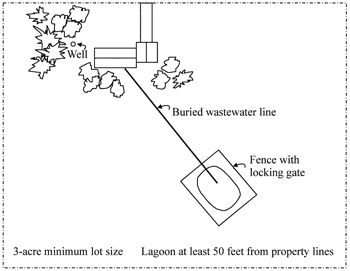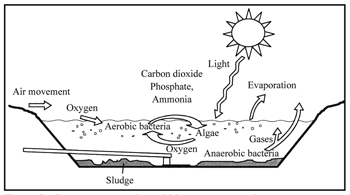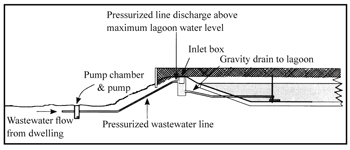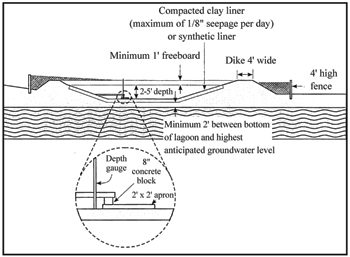G1441
Residential Onsite Wastewater Treatment: Lagoon Design and Construction
This NebGuide discusses recommended practices for the design and construction of lagoon systems for treatment of residential wastewater to help homeowners better understand procedures used by certified onsite professionals.
Jan R. Hygnstrom, Extension Project Manager
Sharon O. Skipton, Extension Water Quality Educator
Wayne E. Woldt, Extension Environmental Engineer
- How Does Treatment Occur?
- Lagoon Location
- Lagoon Design
- Constructing the Lagoon
- Summary
- Publication Support
|
A properly designed, installed, and maintained lagoon is an approved method of wastewater treatment for a private residence in areas where public wastewater treatment systems are not available. A lagoon (Figure 1) is a good alternative for wastewater treatment and disposal where soil has high clay content with poor drainage, and the lot is at least three acres in size.
This NebGuide provides an overview of available information on lagoon design. It is not intended to provide all information required to design a lagoon for a particular site or situation, or to guarantee compliance with Nebraska regulations. For more information on lagoon design, and to ensure that a lagoon design is in compliance with Nebraska regulations, see Nebraska Department of Environmental Quality (NDEQ) Title 124 — Rules and Regulations for the Design, Operation, and Maintenance of Onsite Wastewater Treatment Systems, December 28, 2003. Local regulations may be more strict than those issued by the state. Contact your city or county health, environmental, zoning, or planning department for local requirements. Operation, maintenance, and repair needs for lagoons are covered in the NebGuide Residential Onsite Wastewater Treatment: Lagoon Maintenance (G1423).
As of January 2004, Nebraska law requires that those individuals siting, laying out, constructing, reconstructing, modifying, repairing, altering, inspecting, or pumping onsite wastewater treatment systems must be certified by the NDEQ, be a Nebraska-licensed professional engineer, or a registered environmental health specialist.
How Does Treatment Occur?
Throughout the lagoon, physical, biological, and chemical processes take place that result in wastewater treatment (Figure 2). The wastewater in a lagoon naturally stratifies into three layers — aerobic, anaerobic, and an intermediate or mixed layer. Different conditions exist in each layer, and treatment takes place in all three. Wind and sunlight on the lagoon surface play important roles, and lagoons are designed to optimize their effect. Time is also an important factor in wastewater treatment, so lagoons are designed for adequate retention times.Lagoon Location
A lagoon cannot be installed or operated on a lot less than three “buildable” acres in size.
A site plan showing all physical features and contour elevations will help in lagoon design and location. Site a lagoon downslope from the house so wastewater will flow by gravity to the lagoon. NDEQ requires that the pipe carrying wastewater into the lagoon, called the influent line, have a grade of not less than 1/8 inch per foot. Ideal slope is about two feet per 100 feet (1/4 inch per foot).
Sometimes a lagoon must be located upgrade of the house. In this case, the system will need a pump and pump chamber, which requires an energy source and maintenance, and is subject to failure. When uphill pumping is necessary, the installer should use a high quality sewage or grinder pump. When choosing the site, consider the potential for odors or accidental discharge. Due to prevailing wind patterns in Nebraska, odors are less likely to be an issue when the lagoon is northeast or east of the house.
To protect human health and the environment, NDEQ requires minimum setback distances from the lagoon. Select an inconspicuous site out of 10-year flood elevations, and away from easements or rights-of-way, while maintaining all setback distances (Table I). All buried electrical, gas, or other utility lines must be located prior to excavation. Nebraska state law requires that Diggers Hotline of Nebraska (811) be notified at least 2 business days prior to excavation. The hotline will contact local utilities to mark registered electrical, gas, phone, fiber optics, cable, public water supply, and public sewer lines on the property. Be sure to check local codes as they may be more stringent than state requirements.
| Table I. State minimum setback distances to lagoon (local codes may be more stringent). | |
| Item | Distance from Lagoon |
| Surface water | 50 feet |
| Private drinking water wells | 100 feet |
| Public drinking water wells: Noncommunity system Community system |
100 feet 500 feet |
| Water lines: Pressure-main Pressure service connection Suction lines |
25 feet 25 feet 100 feet |
| Trees | 50 feet |
| Property lines | 50 feet |
| Foundations (except neighbors’) Class 1 foundations Class 2 foundations Class 3 foundations |
100 feet 100 feet 50 feet |
| Neighbors’ foundations Class 1 foundations Class 2 foundations Class 3 foundations |
200 feet 200 feet 100 feet |
| Class 1 foundations: Full basements or non-basement footing foundations and slab on grade for living quarters that are lower in elevation
from the onsite wastewater treatment system. Class 2 foundations: Non-basement footing foundations, trailer houses and slab on grade living quarters that are higher in elevation than the onsite wastewater treatment system. Class 3 foundations: Structures using slab on grade construction and are not used as living quarters. |
|
To protect surface water, the top of the dike must be at least 1 foot above the 100-year flood elevation. To reduce the chance of groundwater contamination, the bottom of the lagoon must be at least 2 feet above the highest expected groundwater level or fractured bedrock.
Lagoon Design
Shape
A lagoon can be round, square, or rectangular. Corners should be rounded. Its length should not be more than three times its width.
Capacity
A lagoon’s surface area must be large enough to support needed algal growth and maintain aerobic conditions in the lagoon’s top layer. In addition, a lagoon must be large enough to hold all wastewater since Nebraska regulations prohibit discharge from a private lagoon. Water losses are through evaporation to the atmosphere and minimal leakage or seepage. Seepage from the lagoon must not exceed 1/8 inch per day.
While water level will vary throughout the year, the lagoon should be sized to maintain wastewater at a depth of 2 to 5 feet. A minimum depth of 2 feet is necessary to prevent the bottom from drying out, maintain anaerobic conditions at the bottom, reduce odors, and prevent rooted plants from growing in the lagoon. A maximum depth of 5 feet is recommended to maintain the anaerobic, intermediate, and aerobic layers. The lagoon should have a permanent measuring device to monitor water level.
Lagoon size is based on climate, including evaporation and precipitation rates, and the number of bedrooms in the site’s dwelling. This last item is an indication of gallons of wastewater discharged per day. The volume of liquid entering a lagoon as wastewater and precipitation should be approximately equal to the volume emitted through evaporation and seepage. NDEQ’s Title 124 contains sizing guidelines and equations.
Example 1. A lagoon handling wastewater from a three-bedroom home in Scottsbluff, Neb., needs a surface area of 2,235 square feet. A lagoon for a home the same size in Lincoln, Neb., needs a surface area of 2,762 square feet. The difference is due to different evaporation and precipitation rates.
Example 2. While a three-bedroom home in Lincoln requires a lagoon with a surface area of 2,762 square feet, a two-bedroom home at the same location requires a lagoon with a surface area of 2,072 square feet. The difference is due to different anticipated discharge volumes.
Sizing a lagoon for a house or other dwelling with several bedrooms and only a few occupants presents difficulties. If a lagoon is sized properly for a house’s number of bedrooms, it might have excess capacity if only a few occupants reside in those many bedrooms. Low wastewater flow into a lagoon may result in shallow water depth, rooted vegetation, habitat for rodents and insects that can transmit disease, poor operation, and excessive odor.
In this situation, a two-cell (or two-pond) lagoon might be designed, with the first cell sized for the minimum number of occupants and the combined cells sized for full occupancy. Only the first cell is used until the dwelling reaches full occupancy. However, the second (empty) cell must be maintained to keep weeds from growing or rodents from burrowing and potentially damaging the liner.
Before putting the second cell into use, the installer must test the final seepage rate. Instructions for this are given later in this guide.
A pipe with a valve connects the first cell to the second. Wastewater should be allowed to rise to 4 1/2 feet to 5 feet deep in the first cell before being drawn down to fill the second cell. Then, wastewater should be drawn down to balance water in the two cells. Once the second cell is put into commission, it is important to maintain the 2- to 5-foot depth in both cells. To prevent organic overload of the first cell, a two-cell lagoon requires a splitter box on the influent line to divide the flow between the two cells in proportion to the storage volume. The branch to the second cell is blocked until it is put into service.
|
Using a Pump
When pumping wastewater up to the lagoon (Figure 3), the wastewater line into the lagoon should enter from the top area of the dike with a siphon break vent so that when the pump shuts off, wastewater from the lagoon does not siphon back into the pump chamber. Alarm floats should be installed in the pump chamber so water use can be stopped if the pump fails. The warning buzzer or light should be on a separate circuit from the pump.
Appearance
A properly designed, constructed, and landscaped lagoon can be inconspicuous or even pleasing in appearance. Maintenance of the lagoon and fence is essential to keep them attractive. A round or oval lagoon will blend into the environment better and be more aesthetically pleasing than a square or rectangular one. Try to place the lagoon so it blends in with existing topography and landscape. Where possible, have the installer dig the lagoon into the ground if clearance to groundwater allows (minimum of 2 feet between bottom of the lagoon and the highest expected level of groundwater), with dikes low on the horizon, rather than making it shallow with dikes high on the horizon. When a high dike is needed, place the fence 4 feet outside the base of the dike so it does not add to the overall height. This also allows room for mowing. Use trees, shrubs, and landscaping berms in the line-of-sight to draw attention away from the lagoon. Remember that trees must not be within 50 feet of the lagoon, as this would restrict air movement and reduce performance. Short shrubs no taller than the dike may be used provided they are not planted on the slopes of the dike.
Permits and Registrations
Nebraska law requires that only NDEQ certified professionals, Nebraska registered environmental health specialists, or Nebraska licensed professional engineers shall site, lay out, construct, reconstruct, modify, repair, alter, inspect or pump an onsite wastewater treatment system. Nebraska law does not require a permit for construction and operation of a conventional residential onsite wastewater treatment system if flows are less than 1,000 gallons per day, and the dwelling has fewer than 10 bedrooms. The system must meet all provisions for design and location as found in Title 124. In these situations, no construction permit is required by the state. When waste from other than domestic sources enters a lagoon, a state permit may be required; contact NDEQ. A seepage rate test is required for each lagoon constructed. Title 124 also states that an onsite wastewater treatment system must not endanger human health and must not cause pollution.
The certified professional, registered environmental health specialist, or professional engineer who constructed, reconstructed, altered, or modified the lagoon must register the system with NDEQ within 45 days of completion. A late fee is assessed if the system is registered after 45 days from completion.
Constructing the Lagoon
Excavation
Typically, a small bulldozer or front-end loader is used for constructing a lagoon. The installer will remove vegetation from the floor of the lagoon area. This vegetation must not be put in the dike since it will gradually decay, causing soil settling. The lagoon floor will be constructed so that it is level and will not allow more than 1/8 inch of seepage per day. Soil borings and/or tests described below will determine whether the natural soil will meet seepage restrictions when compacted, or if soda ash, bentonite, or a synthetic liner must be used.
The interior lagoon side slopes should be no steeper than 3:1, and the exterior dike slopes 4:1. There should be at least 1 foot of freeboard above the normal maximum wastewater depth. The top of the dike should be at least 4 feet wide for easier mowing.
Many soils have a topsoil layer that is more permeable than the clay subsoil. When constructing a lagoon, the installer will strip the topsoil layer from the surface and dike base before excavating the bottom and forming the dike. Then the installer will scarify and compact native soils in place and compact embankment fill in layers no more than 6 inches thick. If rocks are encountered while excavating, the area should be overexcavated by at least 1 foot to remove the rock, then filled and compacted with at least 1 foot of clay material. A 12-inch total thickness of compacted clay soil on the bottom and up the inside slopes of the lagoon will generally provide an adequate seal.
Compaction involves working moist, six-inch fill layers on the lagoon sides and bottom with a sheepsfoot roller until it walks out, or the spikes no longer penetrate the soil. Another option is repeated tillage and packing. Moisture content has a significant impact on compaction. Muddy or saturated soil will not compact well. Soil should be moist enough to easily work into a ball in your hands. The more the soil is manipulated at this moisture content, the more voids will be worked out of it and the less permeable it will be. Careful compaction is extremely important for soil that has marginally suitable permeability for lagoons. A depth marker must be installed near the center of the lagoon prior to filling with water, and can be packed with bentonite or clay soil around its base. The depth marker will help test the seepage rate if using the 5-gallon bucket method described later, as well as verify that wastewater in the lagoon is between 2 and 5 feet deep when it is put into use.
When the dike is completed, the installer will replace topsoil over the outside, top, and upper few feet of the inside of the embankment. The embankment must be seeded to a perennial such as grass and anchored with a straw cover or erosion blanket for soil protection.
Testing Final Seepage Rate
There are three ways to test the final seepage rate of a lagoon to make sure it does not exceed the 1/8-inch per-day limit. One method is to have an independent soil lab take a sample of the soil for testing prior to filling the lagoon. This may be very expensive, and will leave a hole that would compromise the integrity of the lagoon. The hole should be plugged with bentonite or soil of similar material that was removed and then compacted. Another method is the two-barrel test, conducted prior to filling the lagoon. The third method, the 5-gallon bucket test, requires that the lagoon be filled to a depth of 2 feet with fresh water. Do not introduce wastewater into the lagoon until the seepage rate has been determined.
The two-barrel method uses two 55-gallon drums. One is the control drum, which will show water loss due to evaporation or gain due to precipitation. The other is the seepage drum that shows the effects of both weather and seepage. One end of the control drum, and both ends from the seepage drum will be removed. The installer will press one end of the seepage drum a few inches into the sealed soil layer of the lagoon, and pack a bead of bentonite around the inside edge of the drum. This drum must be filled with water and kept filled for at least two days to saturate the soil before conducting the test. Weights suspended from the drum will prevent it from popping up during the test. The top of the drum must remain uncovered as this would interfere with precipitation entry and evaporation, reducing the accuracy of the test. The control drum is set on the lagoon bottom, closed-end down.
Each drum is filled with an equal amount of water. Each day for at least seven days, the difference in levels is recorded and the barrels are refilled to the original levels. The difference between the levels in the two barrels will be due to seepage, and must not be more than 1/8 inch per day.
For the 5-gallon bucket test, the lagoon should be filled with fresh water to a depth of 2 feet and the lagoon water level marked on the permanent depth marker. Then, only precipitation should enter the lagoon. The installer will partially bury a white plastic 5-gallon bucket near the lagoon, and fill it with water to a line marked near the top of the bucket. Water level changes in the bucket will be due to weather conditions. Water level changes in the lagoon will be a result of weather effects and seepage. The water level changes in the lagoon and bucket should be recorded on a daily basis for seven days. As with the two-barrel test, the difference between the two measurements will be the result of seepage, and must not be more than 1/8 inch per day.
If seepage exceeds 1/8 inch per day, the installer will need to add bentonite or soda ash to the lagoon, or drain the lagoon and install a synthetic liner.
Wastewater Line To Lagoon
The installer will use at least a 4-inch diameter sewer line (also known as influent line or distribution pipe) from the house to the lagoon. All joints must be watertight, as leaks attract tree roots that will clog the line, causing a wastewater backup. The pipe should have a loading capacity of not less than 1,000 lb/sq ft. Schedule 40 thermoplastic sewer pipe with solvent welded joints is durable and easy to install.
|
The sewer line trench bottom should be undisturbed soil, free of rocks that could break the line. Ideal line slope is a drop of 1/4 inch (1/8 inch is minimum) over a distance of one foot. This reduces the chance that solids will clog the pipe.
The line must have clean-outs with tight-fitting caps every 75 feet or less, or where the line has angles greater than 45 degrees. There must be one clean-out at least one foot above the highest water level, and near the outside of the dike embankment. Clean-outs may be a Tee or Y fitting, the same size as the sewer line. Cleaning is easier when the line can be accessed in each direction.
The line must enter the lagoon below the water surface to prevent freezing and ice problems during cold weather and must extend to the center of the lagoon. The installer will anchor the end of the pipe to a concrete slab at least 2 feet by 2 feet (Figure 4).
After laying the pipe, the sides and area over the pipe will be carefully backfilled and compacted until 2 inches of fill covers the pipe. The remainder of the trench will be filled and mounded about 6 inches to allow for settling.
Lagoon Fence
A lagoon can attract pets, children, and unsuspecting adults who may think it looks like a good place to play and even swim. Nebraska law requires a fence at least 4-feet high with a locking gate surround a lagoon. A large, rigid, frame-hinged gate with lock provides easy access for mowing and maintenance. The fence may be woven wire, welded wire, or seven strands of barbed wire with the lowest wire 3 inches from the ground and the other strands spaced evenly to a height of 4 feet. The fence should be at the top of the dike, or 4 feet outside the base of the dike. Each gate must have a warning sign that reads “NO TRESPASSING — WASTEWATER LAGOON.”
Summary
A lagoon is a good alternative for onsite wastewater treatment on lots of three acres or more, where a septic tank/effluent system is not feasible due to soil percolation rates. A lagoon can be installed in any type of soil provided a liner is installed that will not allow more than 1/8 inch of seepage per day. For any lagoon system, there must be at least 2 feet of vertical distance between the bottom of the lagoon and groundwater or fractured bedrock. A properly designed, constructed, and maintained lagoon will treat wastewater; protect the environment and human health; and still be inconspicuous or even pleasing in appearance.
Publication Support
Partial funding for materials development was provided by the U.S. Environmental Protection Agency, Region VII and the Nebraska Department of Environmental Quality under Section 319 of the Clean Water Act (Nonpoint Source Programs).
This publication has been peer reviewed.
Visit the University of Nebraska–Lincoln Extension Publications Web site for more publications.
Index: Waste Management
Home Waste Systems
2001, 2004, Revised March 2010



